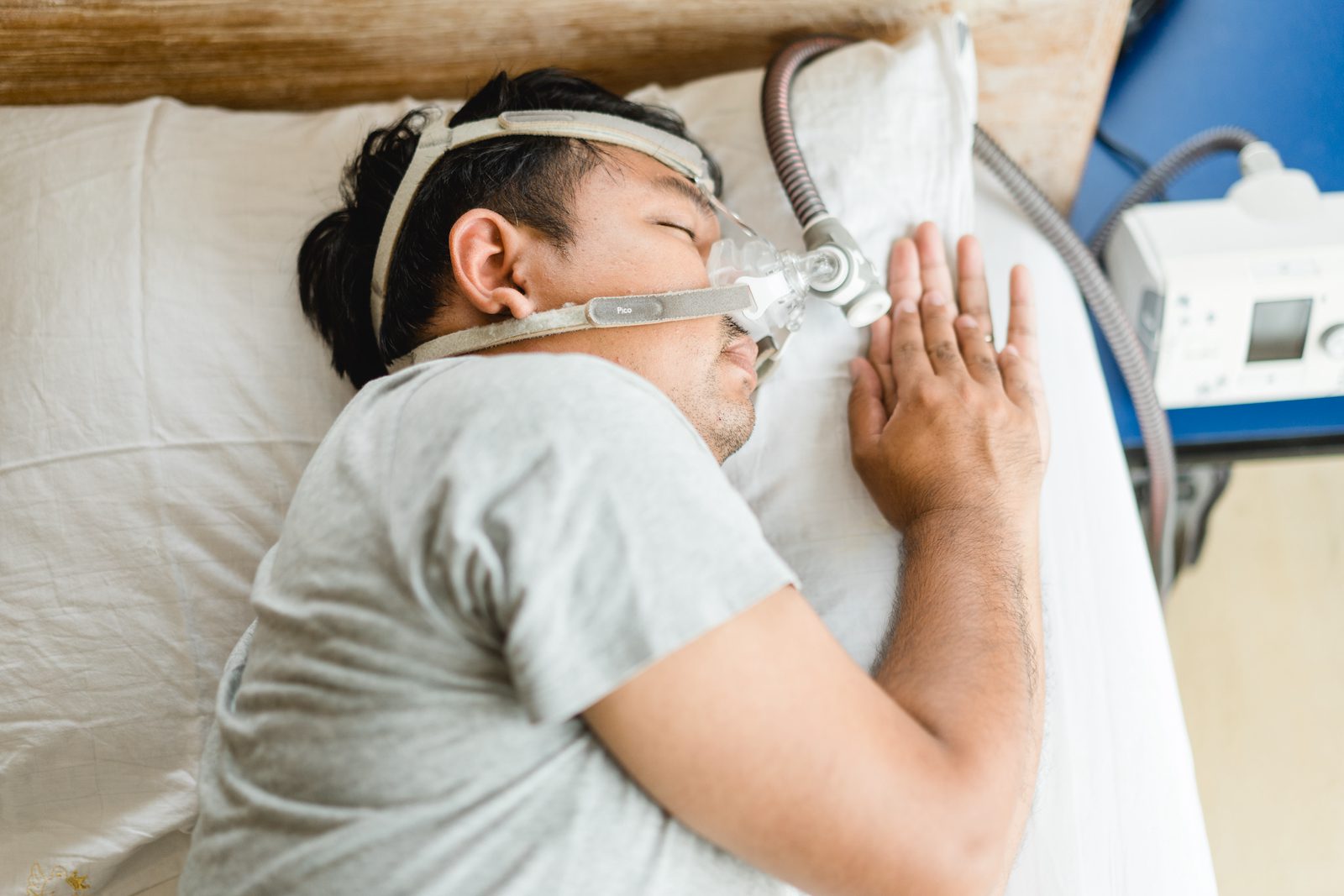A person’s genes can play a direct or an indirect role in the development of sleep apnea, a disorder that causes short but frequent pauses in breathing during sleep. That said, it is difficult to isolate the influence of genetics from other risk factors for sleep apnea, including certain lifestyles and medical conditions.
There are two types of sleep apnea—obstructive sleep apnea (OSA) and central sleep apnea (CSA). In addition to being the most common type, OSA is much more likely to have a genetic basis. We take a closer look at which inherited traits may contribute to these breathing disorders, along with other factors that put a person at risk for an OSA or CSA diagnosis.
How Do Genetics Affect Your Risk for Sleep Apnea?
While central sleep apnea does not appear to be an inherited disorder, obstructive sleep apnea can be genetic. Having a parent, sibling, or child with OSA increases a person’s likelihood of developing OSA by about 50 percent. To understand why only OSA runs in families, it’s important to know how the two forms of sleep apnea differ.
Central sleep apnea happens when the brain momentarily stops communicating with the muscles that assist breathing. CSA is often linked to other medical conditions, such as strokes and brain infections, as well as the use of certain narcotic medications.
While there is no current evidence that a person’s genes directly cause CSA, some genetic conditions, such heart failure, can raise a person’s risk for developing CSA.
On the other hand, there are a number of heritable anatomical features that put a person at greater risk for developing obstructive sleep apnea. OSA happens when the upper airway becomes temporarily blocked, either partially or completely, during sleep. Genetic traits that may contribute to this airway blockage include:
- A narrow throat
- A receded lower jaw
- A high arched hard palate
- An unusually long soft palate
- A large or long tongue
- Obesity, particularly when fat is deposited in the neck, chest, and abdomen
While more research is needed to fully understand the heritability of OSA, studies have associated OSA with polymorphisms—that is, variations in the DNA sequence—in several genes, including:
- Angiopoietin 2 (ANGPT2)
- Tumor necrosis factor-α (TNFα)
- Lysophosphatidic acid receptor 1 (LPAR1) in African Americans
- G protein-coupled receptor 83 (GPR83) in Hispanic Americans
- β-arrestin 1 (ARRB1) in Hispanic-American Females
- Hypoxia inducible factor 1 alpha (HIF-1α) in Hispanic Americans
- Prostaglandin E receptor 3 (PTGER3) in white individuals
Some of these genes are associated with inflammatory responses and with the body’s ability to regulate blood oxygen levels.
What Are Risk Factors for Sleep Apnea?
Additional traits with genetic underpinnings, like sex and race, can influence a person’s risk of developing sleep apnea, but there are also many non-genetic risk factors for sleep apnea. To varying degrees, OSA and CSA have been linked to age, lifestyle, health conditions, and environment. While OSA and CSA risk factors overlap, they are not exactly the same.
Obstructive Sleep Apnea in Adults
A number of risk factors can predispose adults to developing OSA.
- Age: OSA is more likely to develop as people grow older, although the risk generally plateaus around age 80. One possible reason is that airway muscles and tissues tend to loosen as people age.
- Race: Black individuals are more likely to develop OSA than white individuals, particularly at younger ages. This may be because people with African ancestry tend to have more soft tissue in their upper airways.
- Sex: OSA is more commonly detected in men than in women. One reason could be that men have more fat located in the neck and tongue, which can cause the airway to narrow or become blocked.
- Postmenopause: After menopause, women are at similar risk for OSA as men, suggesting that high estrogen, high progesterone, or low testosterone may have protective effects against OSA.
- Obesity: Between 60% and 70% of people with OSA also have obesity, which may be caused by genetics, lifestyle, or both. Fat in the abdomen, neck, and mouth can put strain on breathing muscles and cause the airway to narrow. Obesity is also connected to inflammation and metabolic conditions that may increase the risk of OSA.
- Smoking: People who smoke nicotine products are up to three times more likely to develop OSA than past smokers and people who have never smoked. Smoking increases upper airway inflammation and mucus production, both of which may lead to a narrower airway.
- Nasal congestion: The risk of experiencing sleep apnea rises by two-thirds for people with nasal congestion. Some people may experience chronic nasal congestion as a result of air pollution.
- Medical conditions: OSA is associated with heart disease, lung disease, kidney disease, type 2 diabetes, and stroke, among other medical conditions.
Central Sleep Apnea in Adults
CSA has fewer risk factors than OSA.
- Age: People ages 65 and older have a greater risk of developing CSA, possibly because of the aging process or the presence of other medical conditions, like heart failure, irregular heart rhythm, or stroke.
- Sex: As with OSA, men are more likely to have CSA than women. This is likely due to a difference in hormone levels.
- Medical conditions: Conditions that affect the brain stem, such as cervical spine injuries, brain infections, and strokes can raise the risk of central sleep apnea. CSA associated with Cheynes-Stokes breathing is common in people with heart failure. Kidney failure and irregular heart rhythm may also be associated with CSA.
- Certain medications: Opioid painkillers can make breathing unstable and irregular, leading to CSA if used long term or at high doses. Other painkillers may also increase the risk of CSA because of their effects on the central nervous system.
Sleep Apnea in Children
Children may develop sleep-disordered breathing for a variety of reasons. Risk factors that can lead to sleep apnea in children often involve the upper airway. Children are more likely to develop OSA if they were born prematurely or if they have particular anatomical traits, medical conditions, or environmental conditions including:
- Skull and facial structures that create a narrow airway
- Enlarged tonsils and adenoids
- Obesity
- Asthma
- Allergies
- Exposure to pollution
Risk factors for CSA in children typically involve the central nervous system and its ability to regulate breathing:
- Brain tumors that affect the brain stem
- Brain malformations that affect the brain stem, such as Chiari malformations
- Medications that reduce central nervous system activity and breathing
When to Seek Medical Help
Talk with a doctor if you or a child in your care has signs of OSA or CSA. Getting treatment for sleep apnea can prevent health complications down the road.
Common symptoms of OSA in adults include:
- Loud snoring
- Choking or gasping for air during sleep
- Long pauses in between breaths during sleep
- Morning headaches
- Daytime sleepiness
- Not feeling well-rested after a full night’s sleep
- Mood changes
- Poor concentration
In addition to these symptoms, children with OSA may experience bedwetting, hyperactivity, rebelliousness, and learning difficulties.
CSA symptoms in adults and children include:
- Long pauses in between breaths while asleep
- Insomnia
- Daytime sleepiness
- Shortness of breath at night
- Morning headaches
- Poor concentration
CSA often accompanies other medical conditions, especially ones that affect the heart or central nervous system. Sometimes a doctor suspects a person has CSA while they are being treated in a hospital for a different condition because they experience pauses in breathing or low blood oxygen levels.
After discussing your sleep apnea symptoms and medical history with your doctor, you will likely participate in a sleep study to receive a diagnosis. In a sleep study, your heart rate, breathing, blood oxygen levels, electrical activity, and other physiological variables are monitored overnight at a sleep center or at home.
Once the sleep study is complete, your doctor will discuss the results with you, provide a formal diagnosis, and suggest a variety of treatment options, depending on the type and severity of sleep apnea.



















